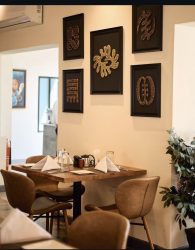…a different approach to conventional building techniques
While most of us are accustomed to building using traditional methods – using materials like cement, sand, stones and iron rods for both residential and commercial structures, among others, many alternative building techniques exist; and they are also generally less expensive than the conventional building approach, according to the experts. Examples include ship containers, bamboo, prefabricated homes, modular homes, straw bales, green housing, timber, ecobricks, and eco panels, to name a few.
The average Ghanaian still views traditional building methods as the only choice, even though many of these alternative housing options—such as prefabricated homes, eco panel, container houses, eco bricks, and many others—are already in the system. These alternative building solutions are, however, somewhat less expensive in terms of labour, materials and other expenses.
This article, therefore, seeks to bring to the fore alternative methods of construction that take into account factors like sustainable building solutions, materials, style or designs, cost-effective home solutions, and speed of work.
Building long-lasting and sustainable homes for those displaced by natural or man-made disasters like floods, chemical or petroleum infernos, etc., often requires quicker development. Alternative building options, such as the use of eco panels, can be faster and can last for a lifespan. The same construction method can be applied to commercial buildings, retaining walls, warehouses and other aesthetics like swimming pools and so on.
Empirical studies show that these environmentally conscious homes are constructed with non-toxic materials, conserve energy, are cost-effective, resistant to fire and earthquakes, and so forth.
Types of alternative building solutions
Eco panel
One of the modern alternatives to traditional housing is the Eco panel system. Research shows that it is a cost-effective, safe and efficient construction technology for erecting structures. In the construction of buildings, the panel can be utilised as a load-bearing or non-load-bearing element.
Additionally, the Eco panel is made of three-dimensional welded wire mesh with an expanded polystyrene core that is non-flammable. To give the panels a cement finishing, polymer cement is then applied.
With the exception of the added advantages like the low temperature, superior sound/noise barrier and many more, it will be quite difficult to distinguish between the traditional and eco-friendly constructions after they are built.
NB: When using a single panel, Eco panel can be erected up to four storeys tall without columns and beams; and when using double panels, it can be built up to 22 stories tall.
Ship container homes
There have been residences made of ship containers for a while now. Shops and offices constitute the majority of its usage as well. Depending on the design, the containers are positioned on a pre-built base either stacked or next to one another.
Openings for windows and doors are typically cut, and the interior is dry walled, insulated, and framed with wood. Building can be developed quickly thanks to the containers, which offer the home or store a contemporary character.
Recycled plastic
I’ve seen some people who are skilled at building homes, pavement blocks and other construction materials out of recycled plastic and empty plastic bottles on social media and in the news. There is already a large supply of recovered plastic. A few of the specialists also have factories or shops that sell these plastic building supplies. They can build your homes based on your design and specifications.
Modular container & prefabricated homes
Prefabricated homes and modular containers are generally detachable and transportable. Bolts hold them together, making installation simple and transportation easier. Both the construction and maintenance expenses are often significantly lower than in a traditional building.
Bridging the housing gap
Government data indicate that Ghana’s housing shortfall is currently more than 1.8 million. The Ghana Statistical Services (GSS) estimates that there was a 33 percent decrease from 2.8 million in 2010 to 1.8 million in 2021. According to research, there has been a 72.8 percent growth in residential structures throughout that period, which is partly responsible for the increase.
There is still a huge void that needs to be filled in spite of the improvements or higher tendencies throughout time.
Despite all the efforts made by various governments and industry players to close the housing gap, experts say that alternative housing approaches should be considered because they are faster to install, more flexible in terms of design, and more affordable.
The experts reiterate that alternative housing options, such as employing Eco panels, are comparatively less expensive, ranging from 7 to 15 percent less costly than traditional building methods. This has the potential to lower housing costs and make it more affordable for the average person.
In order to grow and contribute to closing the housing gap, investors, the government and other stakeholders can take advantage of this if they aren’t already.
Benefits of alternative housing solutions
In Ghana, conventional houses constitute the majority of the housing stock. While these constructions are excellent and resistant to all types of weather, their construction can be costly and occasionally intricate. To address our problems with social housing, alternative building solutions offer smart and comparatively less expensive housing options.
Here’s a summary of the advantages:
Eco-friendly homes are what experts say about alternative housing. This is because they save the occupant money by using energy-saving techniques and non-toxic building materials during both construction and when in use. Because it uses less energy, emissions into the environment are decreased.
It lessens sand winning compared to conventional building. Sand winning can lead to degradation of the environment, loss of water bodies and the vegetation cover. Given that most eco-friendly home technologies employ non-toxic building materials, reducing pollution to the lowest possible level is one of their primary objectives, according to research, as it’s a viable approach to combat climate change.
Additionally, some materials used for the construction of these alternative housing solutions are light, resistant to blast, acoustically efficient and both fire and heat-resistant.
Some tasks consisting of substructure works will be required, but the cost will be cheaper when Eco panel systems are used. Other tasks such as block work, columns, beams – i.e., rods, form work and concrete – will not be required. This would reduce cost in addition to labour cost, which is relatively lower when compared with the conventional structures.
As long as the necessary funds are available, the professionals of this modern building technique can complete the construction of a standard bungalow house in only three weeks. This, however, will be more in terms of the conventional or the traditional method of building.
One distinctive feature of these alternative building options is their adaptability, particularly with regard to remodelling modular containers and prefabricated homes. You can constantly add new features to your home to improve your area.
These eco-friendly residences encourage a healthy way of living. The materials used to build these dwellings are completely safe for the user’s health and enable the owners to concentrate better while going about their everyday activities.
Furthermore, since they are accustomed to many of these building technologies, diasporans who wish to buy properties in Ghana and the homeland should think about alternative building solutions. This technology offers high quality, quick installation, is cost-effective, sustainable and maintains a comfortable temperature indoors.
Conclusion
Even though conventional houses are preferable in our part of the world, the eco-friendly homes are gradually becoming known, especially with the modular container houses, steel and eco panel structures.
I know of a few important government initiatives, as well as other private residences and establishments, which have made use of these alternative housing options. Nevertheless, not many individuals are actually aware of this housing alternative. Despite being relatively simple to build, some private entities do not even consider it while making decisions.
The working class and the average individual must, therefore, consider this option when making a decision to acquire a home, especially those who don’t want to go through the stress of building. Corporate bodies must also consider green housing when expanding and when putting up new offices. More so, real estate companies must start considering this option if they have not already ventured into it. The future is definitely smart and modern alternative housing, and players must start leveraging the opportunities that come with it.
Email: [email protected]










